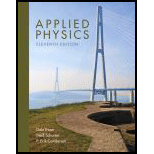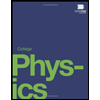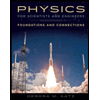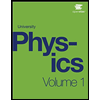
Applied Physics (11th Edition)
11th Edition
ISBN: 9780134159386
Author: Dale Ewen, Neill Schurter, Erik Gundersen
Publisher: PEARSON
expand_more
expand_more
format_list_bulleted
Concept explainers
Textbook Question
Chapter 15.2, Problem 28P
The air density in a tractor tire is 1.40 kg/m3 at a pressure of 314 kPa. (a) As the air pressure increases to 700– kPa, does the final density of the air increase or decrease? (b) What is the resulting density of the air?
Expert Solution & Answer
Want to see the full answer?
Check out a sample textbook solution
Chapter 15 Solutions
Applied Physics (11th Edition)
Ch. 15.1 - Change 15C to K.Ch. 15.1 - Prob. 2PCh. 15.1 - Prob. 3PCh. 15.1 - Change 235 K to C.Ch. 15.1 - Prob. 5PCh. 15.1 - Prob. 6PCh. 15.1 - Prob. 7PCh. 15.1 - Change 375R to F.Ch. 15.1 - T=315 K, V=225 cm3, T=275 K, find V.Ch. 15.1 - T=615R, V=60.3 in3, T=455R, find V.
Ch. 15.1 - V=200 ft3, T=95F, V=250 ft3, find T.Ch. 15.1 - Prob. 12PCh. 15.1 - Some gas occupies a volume of 325 m3 at 41 C. What...Ch. 15.1 - Some oxygen occupies 275 in3 at 35C. Find its...Ch. 15.1 - Some methane occupies 1575 L at 45C. Find its...Ch. 15.1 - Some helium occupies 1200ft3 at 70F. At what...Ch. 15.1 - Some nitrogen occupies 14,300 cm3 at 25.6C. What...Ch. 15.1 - Some propane occupies 1270 cm2 at 18.0C. What is...Ch. 15.1 - Some carbon dioxide occupies 34.5 L at 49.0C. Find...Ch. 15.1 - Some oxygen occupies 28.7 ft3 at 11.0F. Find its...Ch. 15.1 - A balloon contains 26.0 L of hydrogen at 40.0F....Ch. 15.1 - Using Charles's law, determine the effect (a) on...Ch. 15.1 - If 38.0 L of hydrogen is heated to 110C and...Ch. 15.1 - Prob. 24PCh. 15.1 - A hot air balloon contains 147 m3 of air at 19.0C....Ch. 15.1 - A tank with 139 L of propane is cooled from 91.0C...Ch. 15.1 - A 2000 L fuel tank filled with propane at 21C is...Ch. 15.1 - A propane nurse tank is left on a job site...Ch. 15.1 - A propane tank now containing 250L of propane was...Ch. 15.1 - A tank with 500 L of propane is heated from 17.0C...Ch. 15.2 - V'=315 cm3, P=101 kPa, P'=85.0 kPa; find V.Ch. 15.2 - V=450L, V'=700L, P=750 kPa; find P'.Ch. 15.2 - V=76.0 m3, V'=139 m3, P'=41.0 kPa; find P.Ch. 15.2 - V=439 in3, P'=38.7 psi, P=47.1 psi; find V'.Ch. 15.2 - D=1.80 kg/m3, P=108 kPa, P'=125 kPa; find D'.Ch. 15.2 - Prob. 6PCh. 15.2 - P=51.0 psi, P'=65.3 psi, D'=0.231 lb/ft3; find D.Ch. 15.2 - Some air at 22.5 psi occupies 1400 in3. What is...Ch. 15.2 - Prob. 9PCh. 15.2 - Prob. 10PCh. 15.2 - Prob. 11PCh. 15.2 - Some oxygen has a density of 1.75 kg/m3 at normal...Ch. 15.2 - Some methane at 500 kPa gauge pressure occupies...Ch. 15.2 - Prob. 14PCh. 15.2 - Some nitrogen at 80.0 psi gauge pressure occupies...Ch. 15.2 - Prob. 16PCh. 15.2 - Prob. 17PCh. 15.2 - Some propane occupies 2.30 m3 at a gauge pressure...Ch. 15.2 - A quantity of oxygen at a gauge pressure of 20.0...Ch. 15.2 - Some air occupies 4.5 m3 at a gauge pressure of 46...Ch. 15.2 - Some oxygen at 87.6 psi (absolute) occupies 75.0...Ch. 15.2 - A gas at 300 kPa (absolute) occupies 40.0 m3. Find...Ch. 15.2 - A volume of 58.0 L of hydrogen is heated from 33C...Ch. 15.2 - Prob. 24PCh. 15.2 - A 2.00-L plastic bottle contains air at a pressure...Ch. 15.2 - Prob. 26PCh. 15.2 - A mass of 1.31 kg of neon is in a 3.00-m3...Ch. 15.2 - The air density in a tractor tire is 1.40 kg/m3 at...Ch. 15.2 - An unknown gas is in a tank at 13.3 kPa. (a) If...Ch. 15.3 - Use Vp=VPto find each quantity. (All pressures are...Ch. 15.3 - Use Vp=VP to find each quantity. (All pressures...Ch. 15.3 - Use Vp=VPto find each quantity. (All pressures are...Ch. 15.3 - Use Vp=VPto find each quantity. (All pressures are...Ch. 15.3 - Use Vp=VP to find each quantity. (All pressures...Ch. 15.3 - We have 600 in3 of oxygen at1500 psi at 65F. What...Ch. 15.3 - We have 800m3 of natural gas at 235 kPa at 30C....Ch. 15.3 - We have 1400 L of nitrogen at 135 kPa at 54C. What...Ch. 15.3 - An acetylene welding tank has a pressure of 2000...Ch. 15.3 - What is the new pressure in Problem 9 if the...Ch. 15.3 - An ideal gas occupies a volume of 5.00 L at STP....Ch. 15.3 - An ideal gas occupies a volume of 5.00 L at STP....Ch. 15.3 - Some propane occupies 2.00 m3 at18.0C at an...Ch. 15.3 - A balloon with volume 3200 mL of xenon gas is at a...Ch. 15.3 - A 7 85-L helium-filled balloon experiences a...Ch. 15 - Prob. 1RQCh. 15 - Prob. 2RQCh. 15 - Prob. 3RQCh. 15 - Prob. 4RQCh. 15 - Prob. 5RQCh. 15 - Prob. 6RQCh. 15 - Prob. 7RQCh. 15 - Prob. 8RQCh. 15 - Prob. 9RQCh. 15 - What causes the tendency of the volume and...Ch. 15 - What causes the tendency of the temperature of a...Ch. 15 - What causes the tendency of the pressure of a gas...Ch. 15 - A gas occupies 13.5 ft3 at 35.8F. What will the...Ch. 15 - A gas occupies 3.45 m3 at 18.5 C. What will the...Ch. 15 - Some hydrogen occupies 115 ft3 at 54.5F. What is...Ch. 15 - Some carbon dioxide occupies 45.3 L at 38.5C. What...Ch. 15 - Some propane occupies 145 cm3 at 12.4 C. What is...Ch. 15 - Some air at 276 kPa occupies 32.4 m3. What is its...Ch. 15 - Some helium at 17.5 psi gauge pressure occupies...Ch. 15 - Prob. 8RPCh. 15 - We have 435 in3 of nitrogen at 1340 psi gauge...Ch. 15 - We have 755 m3 of carbon dioxide at 344 kPa at...Ch. 15 - A welding tank has a gauge pressure of 1950 psi at...Ch. 15 - An ideal gas occupies a volume of 4.50 L at STP....Ch. 15 - An ideal gas occupies a volume of 5.35 L at STP....Ch. 15 - A volume of 1120 L of helium at 4000 Pa is heated...Ch. 15 - In a 47-cm-tall cylinder of radius 7.0 cm,...Ch. 15 - Fran purchases a 1.85-ft3, helium-filled Mylar...Ch. 15 - An automobile tire is filled to an air pressure of...Ch. 15 - A 15.0-cm-long cylinder has a movable piston with...Ch. 15 - A 0.0300-m3 steel tank containing helium is stored...Ch. 15 - A lightweight weather-collecting sensor is...
Additional Science Textbook Solutions
Find more solutions based on key concepts
Which is more dangerous, a closet where tanks of nitrogen are stored, or one where tanks of carbon dioxide are ...
University Physics Volume 2
BIO Stray voltage is a serious problem on dairy farms, often resulting from corroded wiring or poor wiring prac...
Essential University Physics: Volume 2 (3rd Edition)
4.19 At the surface of Jupiter’s moon Io, the acceleration due to gravity is g = 1.81 m/s2. A watermelon weighs...
University Physics with Modern Physics (14th Edition)
A transverse wave 1.2 cm in amplitude propagates on a string; its frequency is 44 Hz. The string is under 21-N ...
Essential University Physics: Volume 1 (3rd Edition)
55. Susie hammers on a block of wood 85 m from a large brick wall. Each time she hits the block, she hears an e...
Conceptual Physical Science (6th Edition)
The pV-diagram of the Carnot cycle.
Sears And Zemansky's University Physics With Modern Physics
Knowledge Booster
Learn more about
Need a deep-dive on the concept behind this application? Look no further. Learn more about this topic, physics and related others by exploring similar questions and additional content below.Similar questions
- How many cubic meters of helium are required to lift a balloon with a 400-kg payload to a height of 8 000 m? Take He = 0.179 kg/m3. Assume the balloon maintains a constant volume and the density of air decreases with the altitude z according to the expression air = 0ez/8, where z is in meters and 0 = 1.20 kg/m3 is the density of air at sea level.arrow_forwardAn airplane is cruising at altitude 10 km. The pressure outside the craft is 0.287 atm; within the passenger compartment, the pressure is 1.00 atm and the temperature is 20C. A small leak occurs in one of the window seals in the passenger compartment. Model the air as an ideal fluid to estimate the speed of the airstream flowing through the leak.arrow_forwardHow tall must be to measure blood pressure as high as 300 mm Hg?arrow_forward
- Water flows through a fire hose of diameter 6.35 cm at a rate of 0.0120 m3/s. The fire hose ends in a nozzle of inner diameter 2.20 cm. What is the speed with which the water exits the nozzle?arrow_forwardAn ideal fluid flows through a horizontal pipe whose diameter varies along its length. Measurements would indicate that the sum of the kinetic energy per unit volume and pressure at different sections of the pipe would (a) decrease as the pipe diameter increases, (b) increase as the pipe diameter increases, (c) increase as the pipe diameter decreases, (d) decrease as the pipe diameter decreases, or (e) remain the same as the pipe diameter changes.arrow_forwardA backyard swimming pool with a circular base of diameter 6.00 m is filled to depth 1.50 m. (a) Find the absolute pressure at the bottom of the pool. (b) Two persons with combined mass 150 kg enter the pool and float quietly there. No water overflows. Find the pressure increase at the bottom of the pool after they enter the pool and float.arrow_forward
- A fire hose has an inside diameter of 6.40 cm. Suppose such a hose carries a flow of 40.0 LIS starting at a gauge pressure of 1.62106 N/m2. The hose goes 10.0 m up a ladder to a nozzle having an inside diameter of 3.00 cm. Calculate the Reynolds numbers for flow in the fire hose and nozzle to show that the flow in each must be turbulent.arrow_forwardAn airplane is cruising al altitude 10 km. The pressure outside the craft is 0.287 atm; within the passenger compartment, the pressure is 1.00 atm and the temperature is 20C. A small leak occurs in one of the window seals in the passenger compartment. Model the air as an ideal fluid to estimate the speed of the airstream flowing through the leak.arrow_forwardBird bones have air pockets to reduce their weight—this also gives them an average density significantly less than that of the bones of other animals. Suppose an ornithologist weighs a bird bone air and in water and finds its mass is 45.0 g ad its apparent mass when submerged is 3.60 g (assume the bone is watertight.)(a) What mass of is displaced? (b) What is the volume of the bone? (c) What is its average density?arrow_forward
- A garden hose with a diameter of 2.0 cm is used to fill a bucket, which has a volume of 0.10 cubic meters. It takes 1.2 minutes to fill. An adjustable nozzle is attached to the hose to decrease the diameter of the opening, which increases the speed of the water. The hose is held level to the ground at a height of 1.0 meters and the diameter is decreased until a flower bed 3.0 meters away is reached. (a) What is the volume flow rate of the through the nozzle when the diameter 2.0 cm? (b) What does is the speed of coming out of the hose? (c) What does the speed of the water coming out of the hose need to be to reach the flower bed 3.0 meters away? (d) What is be diameter of nozzle needed to reach be flower bed?arrow_forwardMercury is poured into a U-tube as shown in Figure P15.17a. The left arm of the tube has cross-sectional area A1 of 10.0 cm2, and the right arm has a cross-sectional area A2 of 5.00 cm2. One hundred grams of water are then poured into the right arm as shown in Figure P15.17b. (a) Determine the length of the water column in the right arm of the U-tube. (b) Given that the density of mercury is 13.6 g/cm3, what distance h does the mercury rise in the left arm?arrow_forwardHow many cubic meters of helium are required to lift a light balloon with a 400-kg payload to a height of 8 000 m? Take Hc = 0.179 kg/m3. Assume the balloon maintains a constant volume and the density of air decreases with the altitude z according to the expression pair = 0e-z/8 000, where z is in meters and 0 = 1.20 kg/m3 is the density of air at sea level.arrow_forward
arrow_back_ios
SEE MORE QUESTIONS
arrow_forward_ios
Recommended textbooks for you
 Principles of Physics: A Calculus-Based TextPhysicsISBN:9781133104261Author:Raymond A. Serway, John W. JewettPublisher:Cengage Learning
Principles of Physics: A Calculus-Based TextPhysicsISBN:9781133104261Author:Raymond A. Serway, John W. JewettPublisher:Cengage Learning Physics for Scientists and Engineers, Technology ...PhysicsISBN:9781305116399Author:Raymond A. Serway, John W. JewettPublisher:Cengage Learning
Physics for Scientists and Engineers, Technology ...PhysicsISBN:9781305116399Author:Raymond A. Serway, John W. JewettPublisher:Cengage Learning College PhysicsPhysicsISBN:9781938168000Author:Paul Peter Urone, Roger HinrichsPublisher:OpenStax College
College PhysicsPhysicsISBN:9781938168000Author:Paul Peter Urone, Roger HinrichsPublisher:OpenStax College Physics for Scientists and Engineers: Foundations...PhysicsISBN:9781133939146Author:Katz, Debora M.Publisher:Cengage Learning
Physics for Scientists and Engineers: Foundations...PhysicsISBN:9781133939146Author:Katz, Debora M.Publisher:Cengage Learning College PhysicsPhysicsISBN:9781305952300Author:Raymond A. Serway, Chris VuillePublisher:Cengage Learning
College PhysicsPhysicsISBN:9781305952300Author:Raymond A. Serway, Chris VuillePublisher:Cengage Learning University Physics Volume 1PhysicsISBN:9781938168277Author:William Moebs, Samuel J. Ling, Jeff SannyPublisher:OpenStax - Rice University
University Physics Volume 1PhysicsISBN:9781938168277Author:William Moebs, Samuel J. Ling, Jeff SannyPublisher:OpenStax - Rice University

Principles of Physics: A Calculus-Based Text
Physics
ISBN:9781133104261
Author:Raymond A. Serway, John W. Jewett
Publisher:Cengage Learning

Physics for Scientists and Engineers, Technology ...
Physics
ISBN:9781305116399
Author:Raymond A. Serway, John W. Jewett
Publisher:Cengage Learning

College Physics
Physics
ISBN:9781938168000
Author:Paul Peter Urone, Roger Hinrichs
Publisher:OpenStax College

Physics for Scientists and Engineers: Foundations...
Physics
ISBN:9781133939146
Author:Katz, Debora M.
Publisher:Cengage Learning

College Physics
Physics
ISBN:9781305952300
Author:Raymond A. Serway, Chris Vuille
Publisher:Cengage Learning

University Physics Volume 1
Physics
ISBN:9781938168277
Author:William Moebs, Samuel J. Ling, Jeff Sanny
Publisher:OpenStax - Rice University
Fluids in Motion: Crash Course Physics #15; Author: Crash Course;https://www.youtube.com/watch?v=fJefjG3xhW0;License: Standard YouTube License, CC-BY